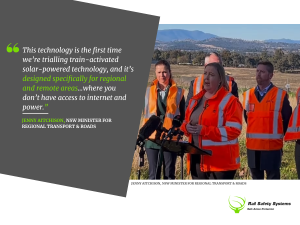The first-of-its-kind trial of the Rail Active Crossing System (RAXS) near Quirindi was discussed on ABC Newcastle, where Director of Freight and Regional Rail Planning for Transport for New South Wales Mark Rowland explained how the technology is designed to improve safety for regional communities.
The Callaghans Lane site has been transformed from a passive to an active crossing in just over a week using modular, solar-powered wireless technology.
Mr Rowland said the system was developed to be both practical and scalable.
“RAXS is built to be affordable, reliable and deployable at scale, so safety improvements are not limited to just a handful of sites. It’s about giving regional communities access to the same protections you see in metropolitan areas.”
He explained how the system works using modern detection and communication technologies to overcome the cost and infrastructure barriers that have long prevented upgrades at rural sites.
“Traditional systems are very expensive to install because they rely on mains power and communications, which in regional areas can be many kilometres away.
“With RAXS, we use solar panels, batteries and advanced wireless technology to detect trains 1.6 kilometres from the crossing and trigger flashing lights and bells without the need for mains power. The system is entirely self-contained and designed to operate in remote conditions.”
Mr Rowland also highlighted the reliability and safety built into the system.
“In rail, you cannot fail. That’s why RAXS uses axle counters to track exactly what enters and exits the system, ensuring precision. If there is ever a rare fault, the system moves to a safe mode, reverting to a stop condition so drivers know how to proceed. This was feedback from regional communities who wanted clear instructions in the unlikely event of a fault.”
The ABC interview also noted the system’s modular design, which allows features such as boom gates, cameras or additional warning signs to be added depending on road and rail traffic volumes.
“One of the innovations is an advance warning sign around 150 metres before the crossing that activates as a train approaches. Communities asked for more visibility, especially at night when coal trains can be hard to see, so the system provides that extra flickering light effect to give drivers more notice.”
The Callaghans Lane location was chosen due to its heavy traffic and risk profile, with almost 30 trains passing daily, including high-speed services. Mr Rowland said the trial is not only about testing the technology, but also about understanding how motorists respond to the new system.
“This type approval process allows us to trial both the technology and the driver behaviour. It’s about making sure communities feel safe, understand what the system means, and that it continues to perform reliably.”








